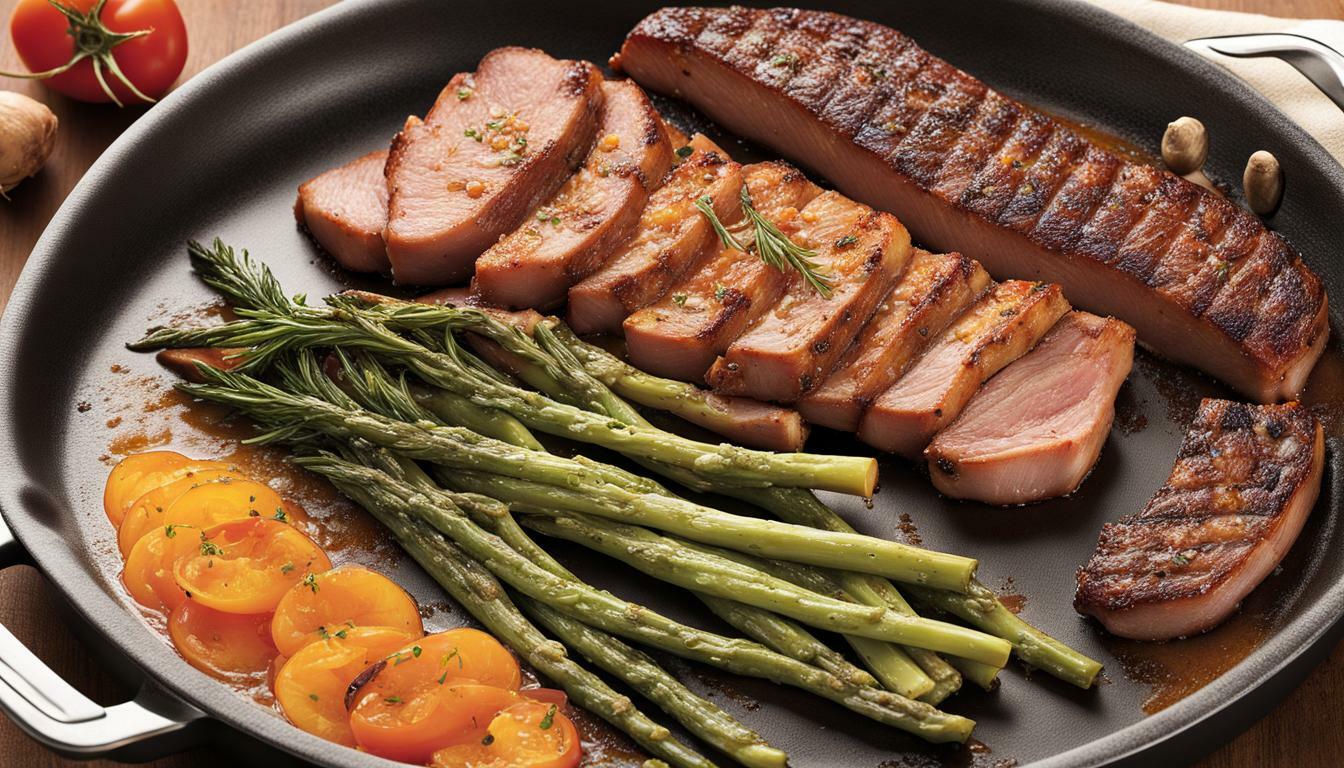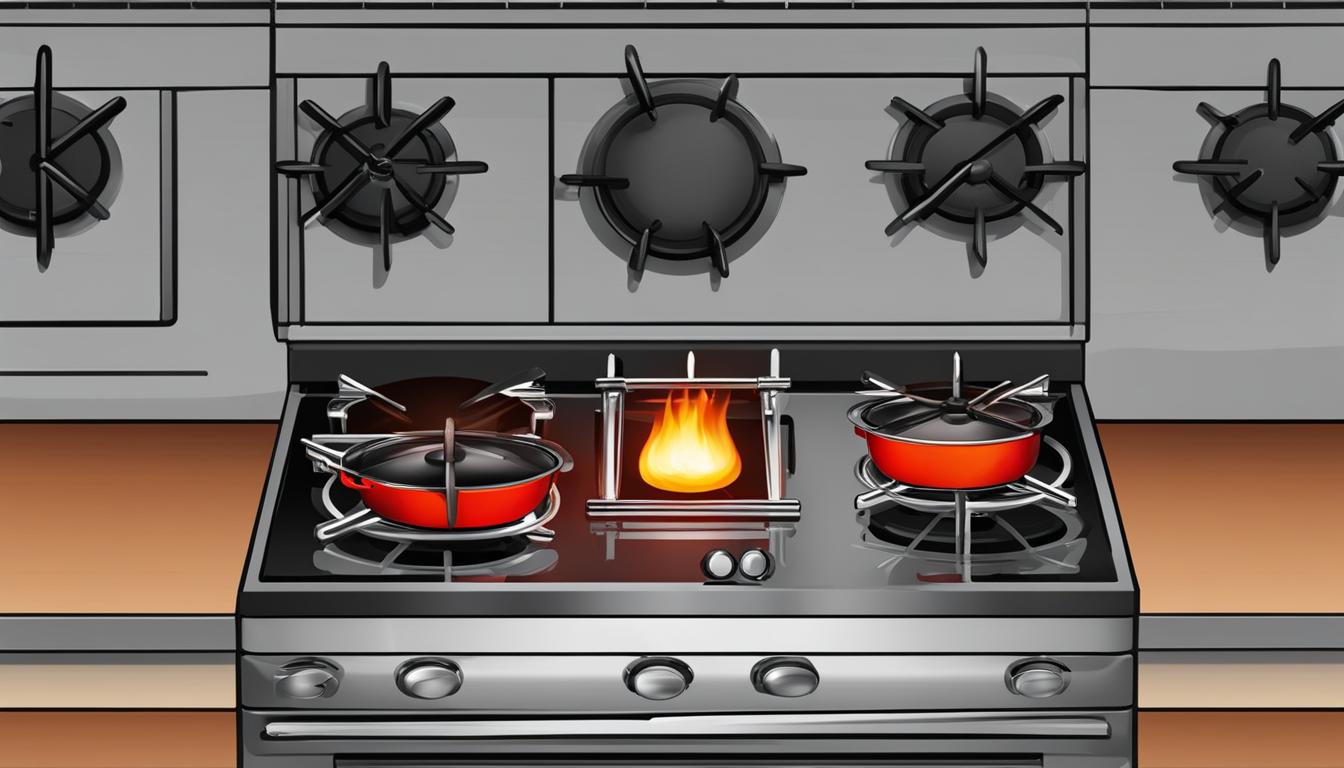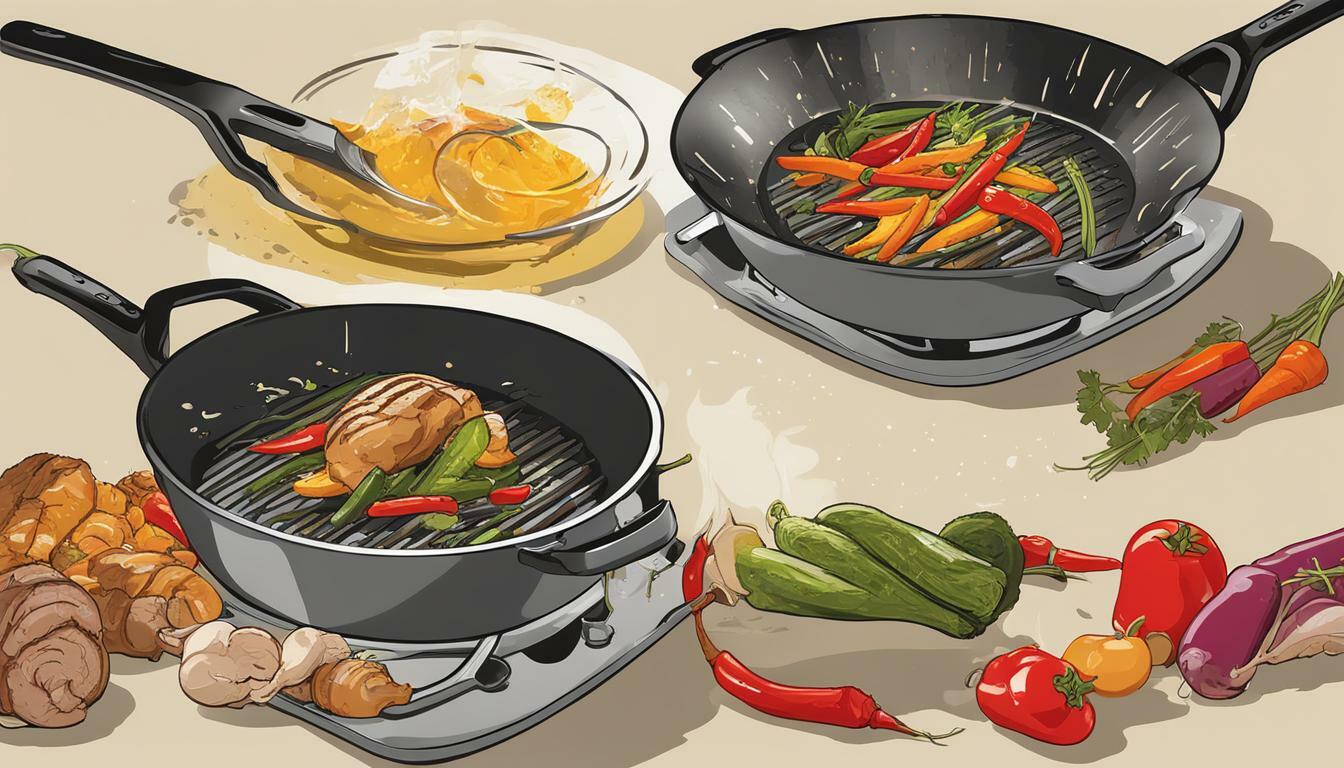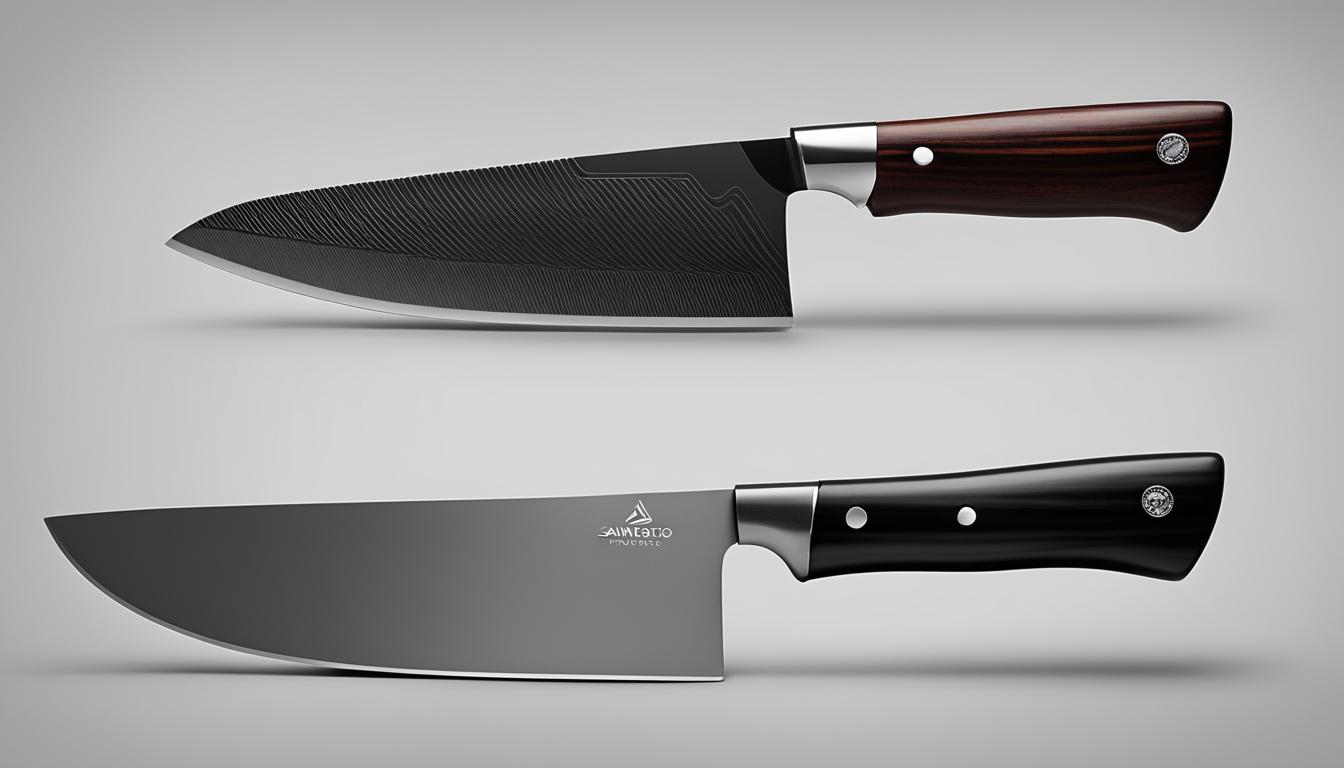When it comes to cooking meat, searing and browning are two techniques that are often used interchangeably. However, they actually differ in terms of their approach and the results they produce. Understanding the differences is crucial for determining the best technique to use in different situations.
Searing is a cooking technique that involves high heat and quick cooking to create a browned crust on the surface of meat. Browning, on the other hand, involves cooking meat over lower heat for a longer period of time until the surface becomes browned. While both techniques are used to enhance flavor and texture, they offer distinct benefits that make them suitable for different types of cooking.
Key Takeaways:
- Searing and browning are two cooking techniques that differ in terms of approach and results.
- Searing involves high heat and quick cooking to create a browned crust on the surface of meat, while browning involves lower heat and longer cooking times.
- Understanding the differences between searing and browning is important for determining the best technique to use in different situations.
Explaining Searing
When it comes to cooking, searing and browning are two techniques that often get used interchangeably, but they are not the same. Searing is a cooking technique where a piece of meat or fish is cooked at high heat, usually in a pan, to create a caramelized crust on the surface of the food. Browning, on the other hand, is a process of cooking food at a lower temperature for a more extended period, causing the Maillard reaction, which results in a browned hue.
When comparing searing and browning, searing is preferred over browning in terms of efficiency and results. The high heat in searing allows for immediate Maillard reaction, which imparts flavor and enhances the texture of the food. Browning, on the other hand, takes time, and the results are often not as intense.
There are various cooking techniques for both searing and browning. The most common is pan-searing, which involves heating a skillet or frying pan until it is very hot, then placing a piece of food in the pan and allowing the surface to cook at high heat until it reaches the desired level of caramelization. Other techniques for searing include grilling, broiling or blowtorching, while browning can be achieved through roasting, sautéing, or stewing.
Benefits of Searing Over Browning
The primary advantage of searing over browning is flavor. Searing intensifies the flavors present in the food, giving it a rich, caramelized taste. It also creates a crispy, crunchy outer surface which adds depth and texture, making it more enjoyable to eat. Additionally, searing is a quick process that locks in the juices of the meat while browning often results in a dry exterior.
Searing is also a healthier cooking option since it does not require the addition of fats or oils and is an excellent method for leaner cuts of meat. By searing meats, you can achieve the same depth of flavor and texture that browning provides, but with fewer calories and fat.
Cooking Techniques for Searing and Browning
The cooking techniques used for searing and browning are crucial to achieving optimal results. For searing, it is essential to preheat the pan to the correct temperature before adding the food. The right temperature will vary depending on the type of food being cooked, but a good rule of thumb is to wait until the oil in the pan begins to smoke, as this indicates that it has reached its smoke point and is ready for cooking. Once the food is added, it is crucial to avoid overcrowding the pan or flipping the food too soon, as this can prevent a good sear from forming.
Browning, on the other hand, requires more time and patience. This method involves cooking food at a lower temperature, typically in an oven or on a stove top, and allowing it to achieve an even brown color throughout. A good browning technique will involve seasoning the meat with salt and pepper before cooking, then searing it briefly to create a flavorful crust. Once seared, the meat can be roasted or slow-cooked until it reaches the desired level of doneness.
In conclusion, searing and browning are both valuable cooking techniques that can help elevate the flavor and texture of your food. However, searing is often the preferred option due to its speed, efficiency, and intense flavor. Regardless of which method you choose, proper technique, and attention to detail are essential to achieving the best results.
Understanding Browning
While searing involves cooking meat quickly over high heat, browning is a slower process that also results in meat with a crispy exterior. However, searing and browning differ in a number of important ways.
When searing meat, a cooking technique commonly used for steaks and other meat cuts, the goal is to cook the surface of the meat quickly, while keeping the inside moist and tender. Browning, on the other hand, is a slow and gradual process that allows the surface of the meat to develop a deep brown color and crispy texture.
Browning can be achieved in a number of different ways, such as by sautéing vegetables or meat in a pan over medium heat, or by slow roasting meat in an oven. When browning meat in a pan, the meat is often coated in flour or breadcrumbs to help create a crispy crust.
Despite their differences, both searing and browning can be effective techniques for enhancing the flavors of meat dishes. However, the specific cooking techniques used for each method will depend on the type of meat being cooked and the desired outcome.
Searing and Browning Techniques
When it comes to searing and browning, there are a few key techniques that can help you achieve the best results:
Temperature
The first and most important step is getting your cooking surface to the right temperature. For searing, you want your pan or grill to be very hot – at least 400°F. Browning can be done at a slightly lower temperature, around 350°F.
Cooking Time
The goal of searing is to create a flavorful crust on the outside of your food while keeping the interior moist and tender. This is typically achieved by cooking the food for a short period of time over high heat. Depending on the food, searing can take anywhere from 1-5 minutes per side. Browning, on the other hand, is typically done over a longer period of time. The food is cooked until it reaches the desired internal temperature, developing a rich brown color and deep flavor in the process.
Techniques
There are a few different techniques you can use to achieve optimal searing and browning results:
- For searing, use a dry cooking surface like a cast iron skillet or grill grates. This will allow the heat to penetrate the food without creating steam or excess moisture.
- For browning, you can use a variety of cooking surfaces including a roasting pan in the oven, a slow cooker, or even a pressure cooker.
- Regardless of the cooking surface, make sure to use plenty of oil or fat to help create a flavorful crust on the outside of your food.
By mastering these techniques, you’ll be able to create delicious, restaurant-quality meals at home that are sure to impress.
Benefits of Searing
If you’re looking to elevate the flavor of your dishes, searing is a technique you should consider. While both searing and browning can add depth to your meals, searing has some unique advantages that make it the preferred method for many chefs.
One of the main benefits of searing is that it results in a beautiful crust on the outside of your food, which can add texture and complexity to the dish. This is especially true for meats, where a seared crust can help to lock in moisture and create a more tender, juicy piece of meat.
In addition to the texture benefits, searing can also enhance the flavor of your dishes. When you sear your food, you’re creating a Maillard reaction, which creates new flavor compounds that weren’t present before. This can give your dishes a more complex, nuanced flavor profile that sets them apart from dishes that have only been browned.
Finally, searing can also be a healthier cooking method. Because you’re cooking your food quickly at a high temperature, you’re not adding as much oil or fat to your dishes. This can help to reduce the calorie count of your meals, without sacrificing flavor or texture.
If you’re looking to take your cooking to the next level, searing is a technique that’s definitely worth trying. Whether you’re cooking meats, vegetables, or any other type of food, searing can help to create a beautifully textured, flavorful dish that’s sure to impress.
Benefits of Browning
Browning is a cooking technique that can add a lot of flavor and depth to dishes.
When you brown meat, whether it’s chicken, beef or pork, you create a rich, caramelized exterior that brings out the savory flavors of the meat.
Browning also adds texture to foods, which can make it more appealing. For example, if you’re making a stew, browning the meat before adding it to the pot will give it a nice sear that will hold up well during the stewing process.
Browning is also a great way to add complexity to dishes. When you brown vegetables like onions, garlic or mushrooms, you create an extra layer of flavor that can take a dish from good to great.
While searing is great for achieving a crispy crust on meat, browning is perfect for creating a deep, rich flavor that permeates the entire dish and lingers on the palate.
So if you’re looking to add some depth and richness to your dishes, try browning your ingredients before cooking. You won’t be disappointed!
Choosing Between Searing and Browning
When it comes to choosing between searing and browning, there are a few factors to consider. One of the main differences between the two techniques is the level of heat used.
Searing involves using very high heat to quickly cook the outside of the meat, creating a caramelized crust and locking in juices. This technique is best suited for cuts of steak or other meats that are already tender and don’t require a long cooking time. On the other hand, browning involves using lower heat to cook the meat more slowly, allowing it to cook through while developing a browned exterior.
If you are cooking a tougher cut of meat, such as a brisket or roast, then browning is most likely the best method. This will allow the meat to cook through more slowly, slowly breaking down and tenderizing the tougher cuts.
However, if you are cooking a tender cut of meat, such as a steak or fillet, then searing is likely the best choice. This method will create a delicious crust on the outside while keeping the inside juicy and tender.
Ultimately, the choice between searing and browning comes down to personal preference and the type of meat you are cooking. Experiment with both techniques to find the method that gives you the best results.
Conclusion
Overall, searing and browning are two distinct cooking methods that can both add depth of flavor and texture to dishes. Searing involves quickly cooking meat or vegetables over high heat to create a crispy, caramelized exterior, while browning requires longer cooking times to bring out the natural sugars in food and create a rich, browned crust.
When deciding whether to sear or brown your food, it’s important to consider the type of food you are cooking and the desired end result. For example, searing is great for steaks and other cuts of meat that require a crispy exterior while remaining rare or medium-rare on the inside. Browning is ideal for stews and soups, where the Maillard reaction can help develop complex flavors over long cooking times.
Ultimately, the choice between searing and browning comes down to personal preference and the specific dish being cooked. By understanding the differences between these two cooking methods and experimenting with different techniques, home cooks can take their cooking skills to the next level and create delicious, restaurant-quality meals in their own kitchens.
 Skip to main content
Skip to main content


